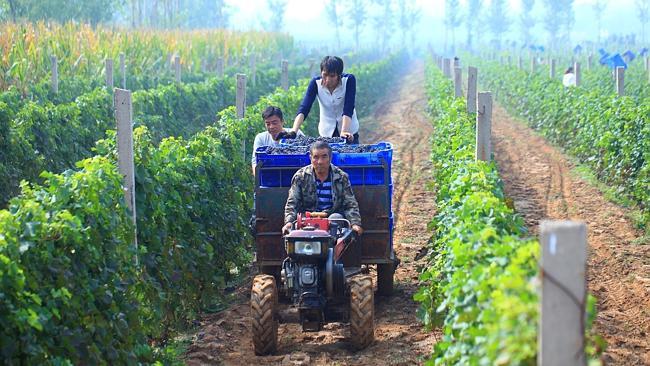Chinese wines on rise as Grace Vineyards, Chateau Changyu gain ground
The Middle Kingdom’s wine industry is gaining ground on its Western counterparts.

On a rare clear day Grace Vineyard, 500km southwest of Beijing, might be mistaken for a chic winery in Tuscany. The balcony doors of the Italianate mansion open over lush rows of grape vines stretching to the horizon, where mountains hover in the heat haze. Picnic tables sit scattered in the garden beneath slender trees, rustling in the dry wind.
Take a stroll outside the winery gates, and you step into the heart of provincial China. The unpaved laneways lead to farming villages where crumbling facades are daubed with old Communist Party slogans and hung with tattered red flags. The motorbikes rattling past are beaten-up relics from Mao’s day, and the grape pickers moving through the fields wear traditional broad peasant hats.
Beyond lie the half-forgotten byways of Shanxi province, a region renowned in the imperial era as a rich trade centre. Only a short drive away are the remnants of China’s ancient glories, such as the enormous Chang Family Manor, the luxurious abode of Ming Dynasty tea merchants.
But Grace Vineyard is focused on China’s future. In the elegant dining room, which is adorned with contemporary artworks, a small army of local servers glide professionally around me. While the kitchen prepares a banquet of delectable Shanxi treats including “scissor-cut noodles”, sauteed river fish and fried “bing” pastries, the fastidious wine steward creeps up at regular intervals to refill my glass with Grace’s flagship cabernet blend, the velvety Chairman’s Reserve, ranked 85 by US wine critic Robert Parker’s website for its subtle blackberry flavours and hints of bay leaf, pepper and cedar.
Grace Vineyard is in the forefront of one of China’s more improbable trends as the most successful of a new wave of boutique wineries. There are now more than 400 such vineyards in the country, mostly in the dry terrain of Shanxi and Ningxia in the north, and wine consultants from France, California and Australia are becoming as common as foreign IT experts in Shanghai.
What’s more, wine critics have been paying attention ever since 2012, when four Chinese reds led by Grace’s Chairman’s Reserve beat French Bordeaux in a blind taste test in Beijing with international judges. Although some in France cried foul — wines had to be less than $100, including 48 per cent tax on foreign wine — the surprise result was hailed by patriots as heralding the arrival of the Chinese industry.
An affinity for grape wine seems culturally far removed from the Middle Kingdom. For about 4000 years, the Chinese have preferred rice wine, a dark, fortified brew that resembles a dry sherry. And like many uninformed outsiders, when I am first offered a glass of Chinese wine in Shanghai’s spectacular restaurant, M on the Bund, I think it is a practical joke. The idea tends to provoke remarks about toxic side-effects — losing tastebuds, for example, or even the sight in one eye.
“A few years ago, you might have been right,” M on the Bund’s Australian owner Michelle Garnaut says, handing me a glass of Grace’s latest chardonnay as we stand on the balcony facing futuristic skyscrapers. The first sip is a surprise: crisp and bright, with subtle nectarine flavours.
Grape wine was first grown commercially in China in 1892, using vines imported from California, and production began expanding again after the embrace of capitalism in the 1980s. But the emphasis was then on quantity rather than quality. To glimpse an old-school winery, I make the pilgrimage one drizzly afternoon to the descendant of the original 1892 producer, the oddly-named Chateau Changyu AFIP Global, located in a rural district 90 minutes by road northeast of Beijing.
The vineyard isn’t hard to spot since, as the name suggests, it boasts a reproduction French chateau, its elegant turrets rising above verdant vineyards. The sense of Disney fantasy only increases as I enter an attached wing of the winery complex, called Foreign Town, a faux European village complete with medieval church and Holy Grail Store, all deserted but awaiting busloads of tourists.
Accompanying me is Beijing-based wine blogger Jim Boyce, who has the slightly dishevelled appearance and acerbic wit of Newman from Seinfeld. A young guide named Nan Xia takes us to inspect the underground cellar adorned with Arthurian coats of arms and a museum with a photo of Changyu wines being served to President Obama at a state dinner. The tour ends up in a cavernous tasting room, where a young sommelier serves a 2008 chardonnay at room temperature to an elevator version of the theme song from the Titanic movie.
“I would describe this wine as anaemic,” Boyce notes. “There’s not much nose. But at least it’s clean.” When told that it sells for more than $120 a bottle, Boyce almost drops his glass. “I can buy a Chilean bottle for $15 at any supermarket in Beijing — and it’s better! Why would I buy this wine?” The sommelier grins and turns up his palms. “I don’t know!”
Nan Xia is unperturbed by the bad review. “Can we all take a photo together?” She gives Boyce her business card in case he hears of a job for her at another winery.
After Changyu it’s easy to understand why the arrival of smaller producers such as Grace causes such excitement among China’s wine-lovers. It is still early days and the boutique wines are expensive, thanks to their small-scale production and China’s high transport costs, retailing from $50 to $100, and production in some vineyards is minuscule. And yet the potential is undeniable, as the country has the soil, the climate and an aptitude for the technical aspects of wine production; the range of domestic wines is expanding, like everything in China, at an ever-accelerating speed.
The success of Grace Vineyard is a model for the industry, even though its birth sounds like the premise for a reality TV show. “We’re considered a miracle,” says Judy Chan, chief executive of the family-owned company, who was only 24 when she was handed the reins of the five-year-old winery in 2002.
A former banker at Goldman Sachs in Hong Kong, Chan’s only knowledge of wine was as a teenager on holiday in Burgundy, where she drank two glasses of red and fell asleep on the couch. “When the winemakers mentioned cabernet sauvignon, I didn’t know what they were talking about,” she says.
Chan quickly hired an Australian wine consultant, Ken Murchison; to improve quality, he had half the original vines uprooted. Soon Grace was attracting the attention of international critics. (Murchison retired last year.)
The breakthrough came when the iconic Peninsula hotel group began to serve Grace wines. China’s other five-star hotels soon followed. Today, Chinese middle-class diners form the main part of the market, although there is still a prejudice against Chinese wine among foreigners, Chan admits. “People forget that when Californian and Australian wines first came out, consumers were very, very sceptical. The French looked down their noses for decades at the Napa Valley,” she says.
Many believe that prospects for local winemakers can only improve.
“It’s true that Chinese wine doesn’t have a recognisable identity yet, unlike, say a classic Napa or Clare Valley wine,” says David Shoemaker, sommelier at the Pudong Shangri-La in Shanghai. “But very soon, we will be able to taste a wine and say, ‘Ah, that’s a classic Shanxi’.”
• cnto.org


